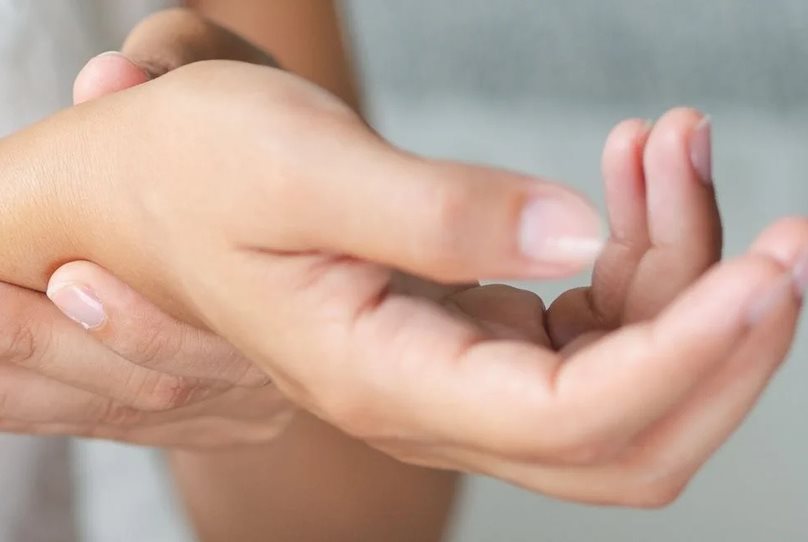Numbness of the hands, tingling sensation in the fingers and pain in the hand area are typical carpal tunnel syndrome symptoms. Here you can find out what this illness involves, what the diagnostic procedure is and what to consider when it comes to treatment and the healing process.
Basics: What is carpal tunnel syndrome?
The carpal tunnel syndrome, also medically referred to as CTS, is a compression syndrome in the wrist-joint area. This means that pressure is exerted on a nerve, resulting in symptoms such as pain in the wrist joint and hand. In some cases, the nerve itself can be damaged.
Among compression syndromes of the peripheral nerves in the areas of the hand, feet, legs and arms, the carpal tunnel syndrome occurs most commonly. It is prevalent in up to ten percent of the population. Based on this study, experts point out that women suffer from carpal tunnel syndrome approximately three to four times more often.What does carpal tunnel syndrome involve?
The carpal tunnel is located in the wrist area. The carpal ligament (flexor retinaculum), which supports the joint, forms a flexible tunnel together with the carpal bones. The mid-arm nerve (median nerve) along with nine muscle tendons runs through this passageway. The carpal tunnel syndrome is a nerve compression syndrome and is caused by compression on the median nerve.
When the carpal tunnel is too narrow, for various reasons, persistent pressure is exerted onto the nerve, which can result in the nerve being damaged. Constriction of the tunnel may possibly go unnoticed in one’s younger years. CTS is commonly diagnosed starting between the age of 40-60. The syndrome most commonly occurs in both hands.
Causes of carpal tunnel syndrome
Based on a comprehensive investigation and survey of patients, key causative factors have been identified. These include, for example:
- excessive physical stress on the wrist joint, such as during physically demanding work, (for example, operating a jackhammer) or repetitive activities
- tumors in the carpal-tunnel area
- misalignment of the bones after a broken hand
- nodular, thickened nerves (ganglia)
- elevated fluid build-up (edema) in the tissue e.g. during pregnancy or due to an underactive thyroid
- degenerative, rheumatic, hormonal and metabolism-related illnesses: more pressure-sensitive nerves due to diabetes mellitus or rheumatoid arthritis, as well as deposition of proteins resulting from amyloidosis
- naturally occurring constriction in the carpal tunnel area (e.g. genetic predisposition or for women)
Can you prevent carpal tunnel syndrome?
To prevent carpal tunnel syndrome symptoms from occurring, one option is to create an ergonomic workplace for everyday work activities. A support for the ball of the thumb when typing on a keyboard and using an ergonomic mouse are useful options. The hands and wrists need to be able to rest comfortably when working at one’s desk. The optimum way to do so is to ensure your upper and lower arm is at a 90-degree angle. Height-adjustable chairs and desks / tables are helpful in this respect.
Persons who engage in sports regularly and exert excessive physical stress on the wrists need to plan in rest periods. This is essential particularly for tennis, bodyweight exercises, squash and volleyball. These rest periods can contribute to preventing excessive physical stress to the wrists.Carpal tunnel syndrome: symptoms indicating CTS

The first signs of CTS include:
- occasional numbness and/or pain of one’s hands
- tingling sensation in the thumb, middle and index fingers
- waking at night due to numbness of the hand which feels ‘furry’
What is the diagnostic procedure for carpal tunnel syndrome?
- Examination and palpation (feeling the area)
- Examination of motor control and surface sensitivity
- Mobility tests, such as the Phalen’s test, the Hoffmann-Tinel sign or the carpal compression test (Durkan test).
Phalen’s Test
For this test, the patient places his/her hands together in front of the chest so that the dorsal surfaces touch each other with fingers pointing downwards. The back of the hands are pressed lightly against one another and the position is maintained for about one minute. In doing so, should abnormal sensations like tingling occur, then this is an indication for carpal tunnel syndrome.
The Hoffmann-Tinel sign
For this test, the patient places the back of his/her hand face up resting on a surface. The attending medical professional then taps with a special small hammer on the site under which the median nerve is located. If the patient perceives a tingling sensation similar to a mild electric shock in the area of the network of nerves, this then is also an indicator for carpal tunnel syndrome.
Treating carpal tunnel syndrome
For a very low degree of carpal tunnel syndrome, it may be sufficient in the initial acute phase to wear a bandage, like the Elastoplast Performance Wrist Support and to thus provide relief for the median nerve. However, as soon as there are signs of the symptoms worsening and one’s sleep is considerably impacted, further therapeutic measures need to be initiated in consultation with a medical doctor. The aim is to avoid the onset of any permanent damage.
As is the case for other illnesses, for the carpal tunnel syndrome, a conservative treatment can initially be provided. Symptoms can be mitigated by way of
- Wrist support/brace
- Taping to ease pain
- Physical therapy
Quite often patients with carpal tunnel syndrome can also benefit from performing exercises at home. For example, stretching exercises specially, squeezing a stress ball or a grip strength trainer for one’s wrist.
Stretch exercise for carpal tunnel syndrome
Is surgery necessary for carpal tunnel syndrome?
How long is the healing period for carpal tunnel syndrome?
The period of time between the diagnosis and carpal tunnel syndrome in the hand and wrist area to heal can vary greatly. Especially for conservative treatments, a great deal of patience is essential, as time is needed to ascertain whether orthoses or exercising will have a lasting success. In a not insignificant number of cases, this can take many months.
A further risk involved in such an arduous course of treatment is the compensating posture automatically adopted by the patient. This can lead to muscle tension and myofascial pain. A worsening of the symptoms can then be the consequence.
It is also of key importance that, during the conservative treatment and as a follow-up to the operation, the patient receives physical therapy. In doing so, the mobility of the wrist can be increased and chronic pain can be prevented.
Whereas a great deal of patience is required for the healing process of conservative treatments, the patient’s wrist joints and hands after an operation can usually be used again with partial strength regained after three weeks. It usually takes about six weeks before the hand’s normal ability to function is restored. After surgery, nine out of ten patients do not experience any further symptoms.

Laura de Bruin graduated in 2013 as a physiotherapist at the Hogeschool Rotterdam. In September 2015 she started the Master's degree in Manual Therapy in Rotterdam. In June
2018 she successfully obtained this degree and started afterwards in September 2021 the Master Psychosomatic Physiotherapy in Utrecht. Laura de Bruin sees importance in the provision of good quality care in an efficient and respectful manner that meets the preferences, wishes and expectations of a client as much as possible. In addition to individual treatments with clients, she supervises exercise groups. In recent years she has also followed several courses for headaches, neck-, shoulder- and back problems.
Disclaimer: Please note that any recommendations and advice given on this website have been compiled with care. However, they are, in no way, meant to take the place of a medical doctor’s consultation and medical treatment. Should you have or assume to have a health-related problem, consult a medical professional – regardless of the information you have received on this website.










